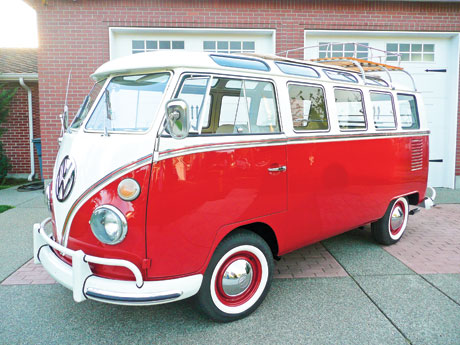As readily recognizable as the immortal Volkswagen Beetle itself, the VW Type 2 and its derivatives enjoyed an even longer period in production than their progenitor. The original was conceived in the late 1940s by a Dutch Volkswagen agent, Den Pon, who drew up plans for a van based on the Beetle floorpan and running gear.
Known as the Volkswagen Type 2 (the Beetle being Type 1), the result of Pon’s efforts arrived in 1950 and almost immediately proliferated into a bewildering variety of models catering to an enormous range of commercial and domestic activities.
Perhaps the most iconic variant was the 21-Window Samba bus, as its skylight windows and Golde sunroof became design hallmarks of the model. The example offered here is recently out of a comprehensive four-year restoration and has lived in the state of Washington most of its life.
SCM Analysis
Detailing
| Vehicle: | 1967 Volkswagen 21-Window Samba Bus |
| Number Produced: | 1.9 million |
| Original List Price: | $1,800 |
| SCM Valuation: | $30,000-$40,000 |
| Tune Up Cost: | $50 |
| Engine Number Location: | At base of generator stand |
| Club Info: | VWCA, 647 Franklin Ave, Council Bluffs, IA 51503 |
| Website: | http://www.vwca.com |
| Alternatives: | 1961-67 Ford Econoline, 1965 Corvair 95 Corvan, 1964-70 Dodge A100 |
This 1967 VW 21-Window Samba Bus, Lot 449, sold for $78,975, including buyer’s premium, at Bonhams and Butterfields Petersen Automotive Museum sale in Los Angeles on November 13, 2010.
The Volkswagen Type 2 bus was produced in at least a dozen variants by the factory and all kinds of other third-party configurations were offered, including fire engines, hearses and police vans. Close to 2 million were produced in the German factory between 1950 and 1967, and production continued in Brazil and Mexico after that, so they are far from scarce even today.
Americans tend to refer to the different models by the number of their windows. The basic Kombi or Bus is the 11-window version with a split windshield, two front cabin windows, six rear side windows and one in the rear. The sunroof deluxe version has eight side windows and two in the rear. It addition it has eight small skylight windows, thus the 23-window designation. In 1964, Volkswagen incorporated a wider rear door on the bus and the rear corner windows were deleted and this model gained the 21-window moniker. Both the 23- and later 21-Window versions are nicknamed “Samba.”
Puffing away very slowly
Those of us from an older generation remember the Volkswagen Microbus as the counter-culture icon from the 1960s. This was the “If you remember them, you weren’t there” period, when Deadheads followed the Grateful Dead from concert to concert. They painted their buses in Flower Power hues and “Make Love Not War” was their theme—and legend has it that a lot of love-making went on in the back of these buses.
Most of the hipsters from that generation eventually got day jobs, cut their hair and joined mainstream American?but the sight of a VW bus brings back a slew of faded, hazy memories.
But while the sight of a Samba Bus can trigger thoughts of a slightly-addled past, following one on a two-lane road is a miserable experience. Powered by an anemic 1,463-cc 4-cylinder engine that produces a mere 53 horsepower, they have difficulty getting out of their own way.
That is coupled with atrocious handling that will scare the heck out of the most fearless of drivers, so they are best relegated to grocery-getter status. This example, when recently restored, was upgraded with a 108-horsepower engine but no mention was made of dealing with the handling.
A nice VW bus, but it’s still a VW bus
The seller states that all the sheet metal and floor pans are original to the bus and the interior has been fitted in the correct, deluxe oatmeal hue material. The deluxe trim has been refinished and the original radio is in place. In addition it sports a roof rack for additional storage when hauling the kids to the beach. It retains the U.S.-spec bumper with rubber inserts and the attractive red-and-white respray was applied to professional standards.
Ever since a 1966 Volkswagen Westfalia Camper sold at Gooding’s August 2005 Pebble Beach sale for an astonishing $99,000, eager sellers have been trying to catch that moonbeam, but to no avail. The seller of this well-presented example referenced that sale and was, of course, hopeful of a similar result.
So, what is a spiffy VW 21-Window deluxe micro bus worth in today’s world?
The SCM database provides numerous examples of 21- or 23-Window buses selling in the $30k range, with a very nice—but far from perfect—example selling at RM’s Monterey August 2008 sale for $71,500 (SCM #117504).
Based on the evidence, we have to think that the RM sale in 2008—along with this one—were aberrations, and $30,000 to $40,000 has been the price point for the past decade and will continue to be so for the foreseeable future. Therefore, we consider this one well sold indeed.
